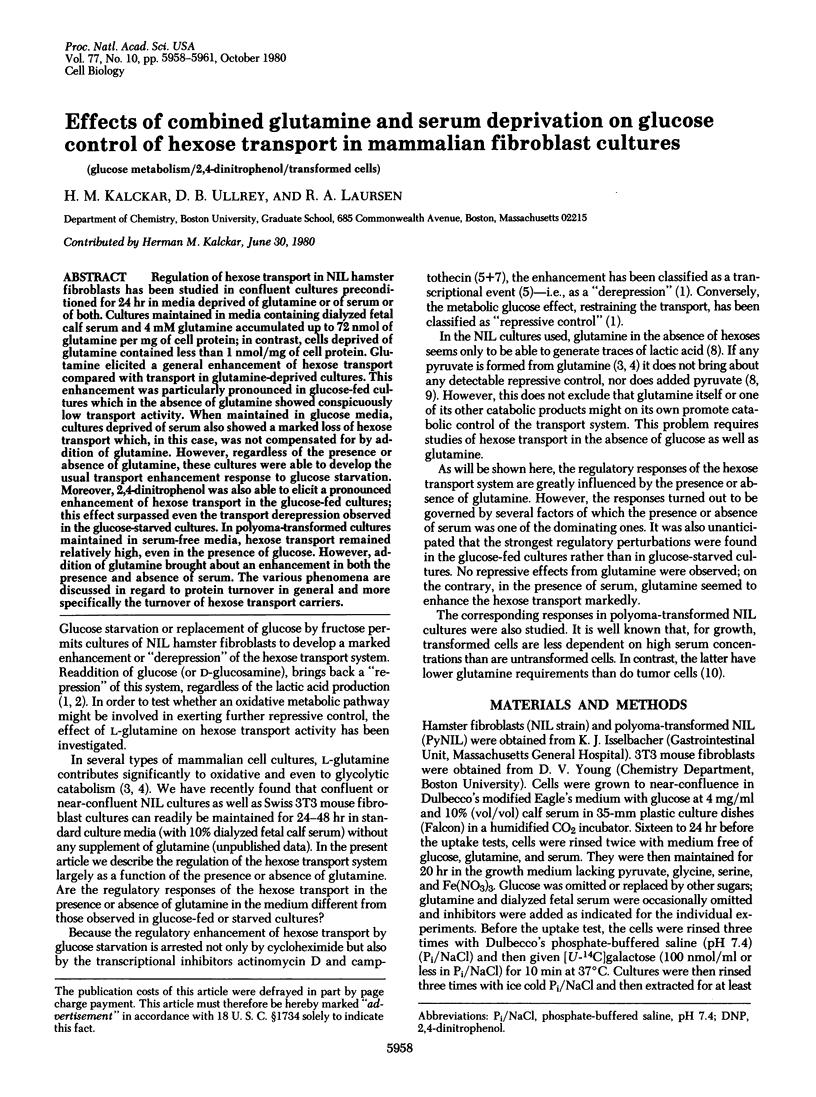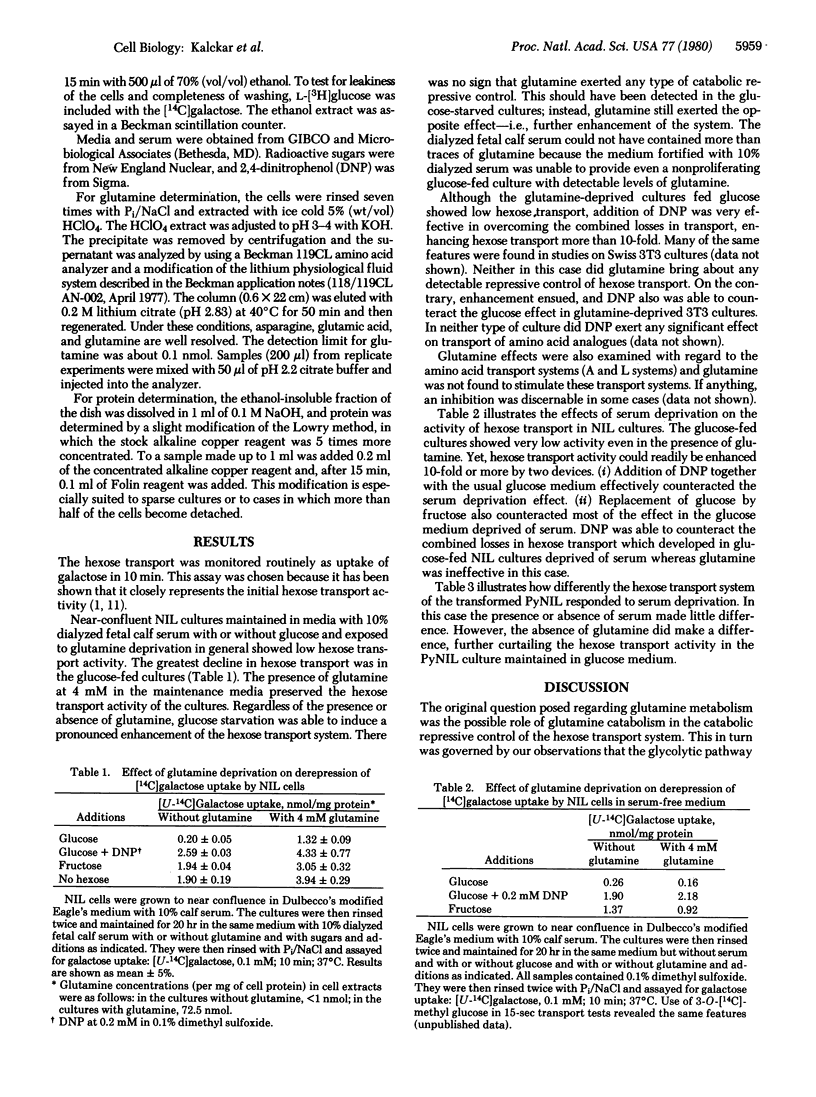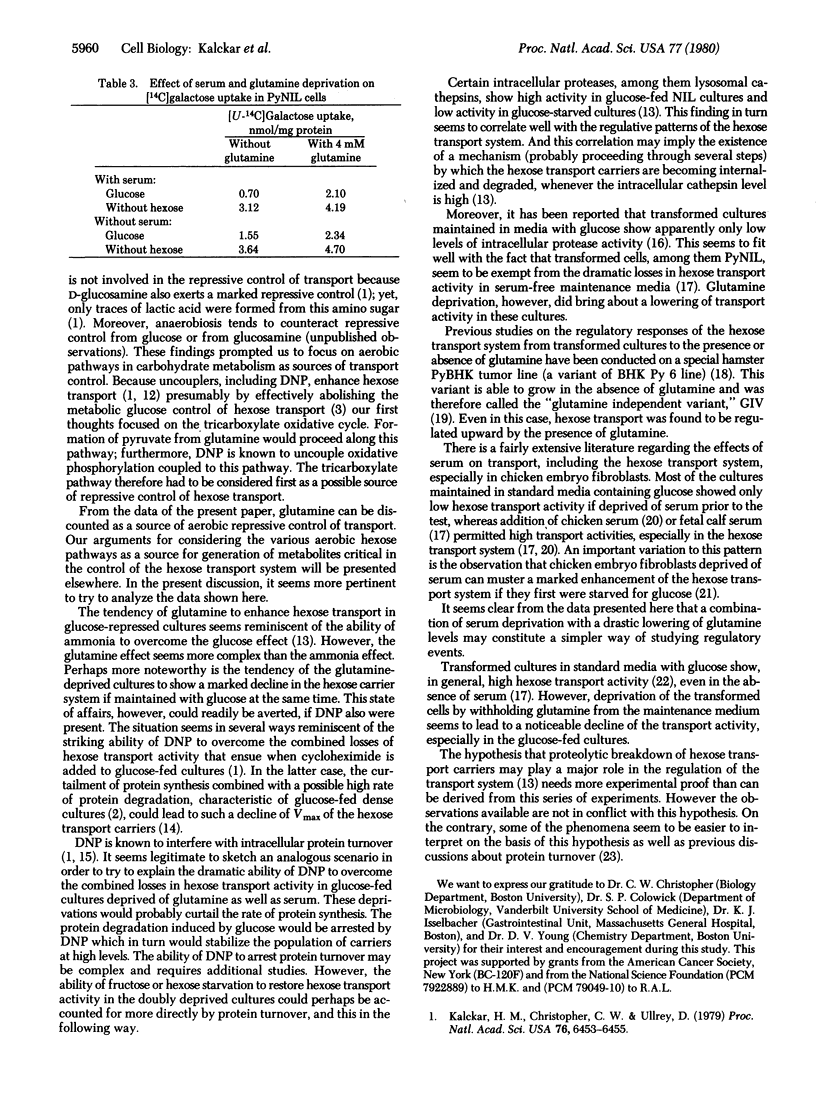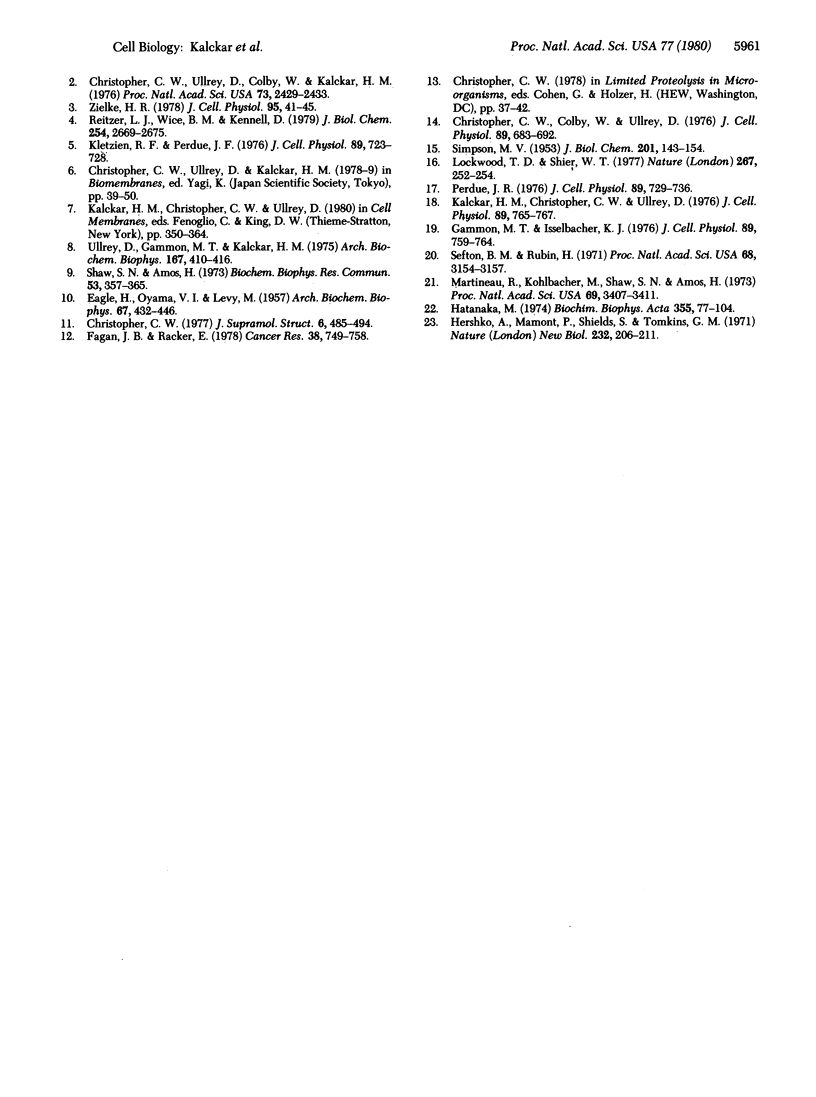Abstract
Regulation of hexose transport in NIL hamster fibroblasts has been studied in confluent cultures preconditioned for 24 hr in media deprived of glutamine or of serum or of both. Cultures maintained in media containing dialyzed fetal calf serum and 4 mM glutamine accumulated up to 72 nmol of glutamine per mg of cell protein; in contrast, cells deprived of glutamine contained less than 1 nmol/mg of cell protein. Glutamine elicited a general enhancement of hexose transport compared with transport in glutamine-deprived cultures. This enhancement was particularly pronounced in glucose-fed cultures which in the absence of glutamine showed conspicuously low transport activity. When maintained in glucose media, cultures deprived of serum also showed a marked loss of hexose transport which, in this case, was not compensated for by addition of glutamine. However, regardless of the presence or absence of glutamine, these cultures were able to develop the usual transport enhancement response to glucose starvation. Moreover, 2,4-dinitrophenol was also able to elicit a pronounced enhancement of hexose transport in the glucose-fed cultures; this effect surpassed even the transport derepression observed in the glucose-starved cultures. In polyoma-transformed cultures maintained in serum-free media, hexose transport remained relatively high, even in the presence of glucose. However, addition of glutamine brought about an enhancement in both the presence and absence of serum. The various phenomena are discussed in regard to protein turnover in general and more specifically the turnover of hexose transport carriers.
Full text
PDF



Selected References
These references are in PubMed. This may not be the complete list of references from this article.
- Christopher C. W., Colby W. W., Ullrey D. Derepression and carrier turnover: evidence for two distinct mechanisms of hexose transport regulation in animal cells. J Cell Physiol. 1976 Dec;89(4):683–692. doi: 10.1002/jcp.1040890427. [DOI] [PubMed] [Google Scholar]
- Christopher C. W. Hexose transport regulation in cultured hamster cells. J Supramol Struct. 1977;6(4):485–494. doi: 10.1002/jss.400060403. [DOI] [PubMed] [Google Scholar]
- Christopher C. W., Ullrey D., Colby W., Kalckar M. Paradoxical effects of cycloheximide and cytochalasin B on hamster cell hexose uptake. Proc Natl Acad Sci U S A. 1976 Jul;73(7):2429–2433. doi: 10.1073/pnas.73.7.2429. [DOI] [PMC free article] [PubMed] [Google Scholar]
- EAGLE H., OYAMA V. I., LEVY M. Amino acid requirements of normal and malignant human cells in tissue culture. Arch Biochem Biophys. 1957 Apr;67(2):432–446. doi: 10.1016/0003-9861(57)90298-9. [DOI] [PubMed] [Google Scholar]
- Fagan J. B., Racker E. Determinants of glycolytic rate in normal and transformed chick embryo fibroblasts. Cancer Res. 1978 Mar;38(3):749–758. [PubMed] [Google Scholar]
- Gammon M. T., Isselbacher K. J. Neoplastic potentials and regulation of uptake of nutrients. I. A glutamine independent variant of polyoma BHK with A very high neoplastic potential. J Cell Physiol. 1976 Dec;89(4):759–764. doi: 10.1002/jcp.1040890438. [DOI] [PubMed] [Google Scholar]
- Hatanaka M. Transport of sugars in tumor cell membranes. Biochim Biophys Acta. 1974 Apr 29;355(1):77–104. doi: 10.1016/0304-419x(74)90008-0. [DOI] [PubMed] [Google Scholar]
- Hershko A., Mamont P., Shields R., Tomkins G. M. "Pleiotypic response". Nat New Biol. 1971 Aug;232(33):206–211. [PubMed] [Google Scholar]
- Kalckar H. M., Christopher C. W., Ullrey D. Neoplastic potentials and regulation of uptake and nutrients. II. Inverse regulation of uptake of hexose and amino acid analogues in the neoplastic GIV line. J Cell Physiol. 1976 Dec;89(4):765–767. doi: 10.1002/jcp.1040890439. [DOI] [PubMed] [Google Scholar]
- Kalckar H. M., Christopher C. W., Ullrey D. Uncouplers of oxidative phosphorylation promote derepression of the hexose transport system in cultures of hamster cells. Proc Natl Acad Sci U S A. 1979 Dec;76(12):6453–6455. doi: 10.1073/pnas.76.12.6453. [DOI] [PMC free article] [PubMed] [Google Scholar]
- Kletzien R. F., Perdue J. F. Regulation of sugar transport in chick embryo fibroblasts and in fibroblasts transformed by a temperature-sensitive mutant of the Rous sarcoma virus. J Cell Physiol. 1976 Dec;89(4):723–728. doi: 10.1002/jcp.1040890432. [DOI] [PubMed] [Google Scholar]
- Lockwood T. D., Shier W. T. Regulation of acid proteases during growth, quiescence and starvation in normal and transformed cells. Nature. 1977 May 19;267(5608):252–254. doi: 10.1038/267252a0. [DOI] [PubMed] [Google Scholar]
- Martineau R., Kohlbacher M., Shaw S. N., Amos H. Enhancement of hexose entry into chick fibroblasts by starvation: differential effect on galactose and glucose. Proc Natl Acad Sci U S A. 1972 Nov;69(11):3407–3411. doi: 10.1073/pnas.69.11.3407. [DOI] [PMC free article] [PubMed] [Google Scholar]
- Perdue J. F. Loss of the post-translational control of nutrient transport in vitro and in vivo virus-transformed chicken cells. J Cell Physiol. 1976 Dec;89(4):729–736. doi: 10.1002/jcp.1040890433. [DOI] [PubMed] [Google Scholar]
- Reitzer L. J., Wice B. M., Kennell D. Evidence that glutamine, not sugar, is the major energy source for cultured HeLa cells. J Biol Chem. 1979 Apr 25;254(8):2669–2676. [PubMed] [Google Scholar]
- SIMPSON M. V. The release of labeled amino acids from the proteins of rat liver slices. J Biol Chem. 1953 Mar;201(1):143–154. [PubMed] [Google Scholar]
- Sefton B. M., Rubin H. Stimulation of glucose transport in cultures of density-inhibited chick embryo cells. Proc Natl Acad Sci U S A. 1971 Dec;68(12):3154–3157. doi: 10.1073/pnas.68.12.3154. [DOI] [PMC free article] [PubMed] [Google Scholar]
- Shaw S. N., Amos H. Insulin stimulation of glucose entry in chick fibroblasts and HeLa cells. Biochem Biophys Res Commun. 1973 Jul 2;53(1):357–365. doi: 10.1016/0006-291x(73)91441-1. [DOI] [PubMed] [Google Scholar]
- Ullrey D., Gammon M. T., Kalckar H. M. Uptake patterns and transport enhancements in cultures of hamster cells deprived of carbohydrates. Arch Biochem Biophys. 1975 Apr;167(2):410–416. doi: 10.1016/0003-9861(75)90481-6. [DOI] [PubMed] [Google Scholar]
- Zielke H. R., Ozand P. T., Tildon J. T., Sevdalian D. A., Cornblath M. Reciprocal regulation of glucose and glutamine utilization by cultured human diploid fibroblasts. J Cell Physiol. 1978 Apr;95(1):41–48. doi: 10.1002/jcp.1040950106. [DOI] [PubMed] [Google Scholar]


